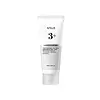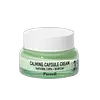What's inside
What's inside
 Key Ingredients
Key Ingredients

 Benefits
Benefits

 Concerns
Concerns

No concerns
 Ingredients Side-by-side
Ingredients Side-by-side

Water
Skin ConditioningPanthenol
Skin ConditioningButylene Glycol
HumectantPropanediol
SolventCaprylic/Capric Triglyceride
MaskingGlycerin
HumectantCetyl Ethylhexanoate
EmollientBehenyl Alcohol
EmollientOctyldodecanol
EmollientPhenyl Trimethicone
Skin ConditioningVinyldimethicone
1,2-Hexanediol
Skin ConditioningBis-Diglyceryl Polyacyladipate-2
EmollientPentylene Glycol
Skin ConditioningCaprylyl Methicone
Skin ConditioningCentella Asiatica Extract
CleansingPolyglyceryl-3 Methylglucose Distearate
EmulsifyingBetaine
HumectantC14-22 Alcohols
Emulsion StabilisingCeramide NP
Skin ConditioningPhytosterols
Skin ConditioningHydroxyethyl Acrylate/Sodium Acryloyldimethyl Taurate Copolymer
Emulsion StabilisingHydrogenated Rice Bran Oil
Skin ConditioningC12-20 Alkyl Glucoside
EmulsifyingAmmonium Acryloyldimethyltaurate/Vp Copolymer
Glyceryl Stearate
EmollientDimethiconol
EmollientGlyceryl Caprylate
EmollientSodium Stearoyl Glutamate
CleansingHydrogenated Lecithin
EmulsifyingGlyceryl Glucoside
HumectantAcrylates/C10-30 Alkyl Acrylate Crosspolymer
Emulsion StabilisingTromethamine
BufferingPolyglyceryl-10 Stearate
Skin ConditioningSodium Hyaluronate
HumectantEthylhexyl Olivate
Skin ConditioningDipropylene Glycol
HumectantSodium Acrylates Copolymer
Polyglyceryl-4 Oleate
EmulsifyingLinolenic Acid
CleansingPolyglyceryl-10 Laurate
Skin ConditioningSphingolipids
EmollientPhosphatidylcholine
Emulsifying4-Terpineol
MaskingAllantoin
Skin ConditioningEctoin
Skin ConditioningHyaluronic Acid
HumectantSqualane
EmollientLecithin
EmollientAsiaticoside
AntioxidantEscin
TonicMadecassic Acid
Skin ConditioningAsiatic Acid
Skin ConditioningBeta-Sitosterol
Emulsion StabilisingTremella Fuciformis Extract
HumectantCeramide AP
Skin ConditioningCeramide EOP
Skin ConditioningGlycine
BufferingGlutamic Acid
HumectantSerine
MaskingAlanine
MaskingLysine
Skin ConditioningArginine
MaskingProline
Skin ConditioningThreonine
Water, Panthenol, Butylene Glycol, Propanediol, Caprylic/Capric Triglyceride, Glycerin, Cetyl Ethylhexanoate, Behenyl Alcohol, Octyldodecanol, Phenyl Trimethicone, Vinyldimethicone, 1,2-Hexanediol, Bis-Diglyceryl Polyacyladipate-2, Pentylene Glycol, Caprylyl Methicone, Centella Asiatica Extract, Polyglyceryl-3 Methylglucose Distearate, Betaine, C14-22 Alcohols, Ceramide NP, Phytosterols, Hydroxyethyl Acrylate/Sodium Acryloyldimethyl Taurate Copolymer, Hydrogenated Rice Bran Oil, C12-20 Alkyl Glucoside, Ammonium Acryloyldimethyltaurate/Vp Copolymer, Glyceryl Stearate, Dimethiconol, Glyceryl Caprylate, Sodium Stearoyl Glutamate, Hydrogenated Lecithin, Glyceryl Glucoside, Acrylates/C10-30 Alkyl Acrylate Crosspolymer, Tromethamine, Polyglyceryl-10 Stearate, Sodium Hyaluronate, Ethylhexyl Olivate, Dipropylene Glycol, Sodium Acrylates Copolymer, Polyglyceryl-4 Oleate, Linolenic Acid, Polyglyceryl-10 Laurate, Sphingolipids, Phosphatidylcholine, 4-Terpineol, Allantoin, Ectoin, Hyaluronic Acid, Squalane, Lecithin, Asiaticoside, Escin, Madecassic Acid, Asiatic Acid, Beta-Sitosterol, Tremella Fuciformis Extract, Ceramide AP, Ceramide EOP, Glycine, Glutamic Acid, Serine, Alanine, Lysine, Arginine, Proline, Threonine
Water
Skin ConditioningCaprylic/Capric Triglyceride
MaskingPanthenol
Skin ConditioningButylene Glycol
HumectantGlycerin
HumectantGlycereth-26
HumectantHydrogenated Poly(C6-14 Olefin)
EmollientOctyldodecanol
EmollientPropanediol
SolventPolyglyceryl-3 Methylglucose Distearate
EmulsifyingCetearyl Alcohol
EmollientCentella Asiatica Leaf Water
Skin Conditioning1,2-Hexanediol
Skin ConditioningCetearyl Olivate
Vinyldimethicone
Sorbitan Olivate
EmulsifyingHydroxyacetophenone
AntioxidantMannitol
HumectantPalmitic Acid
EmollientStearic Acid
CleansingCarbomer
Emulsion StabilisingSodium Acrylate/Sodium Acryloyldimethyl Taurate Copolymer
Emulsion StabilisingTromethamine
BufferingPolyisobutene
Microcrystalline Cellulose
AbsorbentSucrose
HumectantEthylhexylglycerin
Skin ConditioningXanthan Gum
EmulsifyingZea Mays Starch
AbsorbentMelia Azadirachta Leaf Extract
Skin ConditioningDisodium EDTA
Caprylyl/Capryl Glucoside
CleansingHydroxypropyl Methylcellulose
Emulsion StabilisingSorbitan Oleate
EmulsifyingHouttuynia Cordata Extract
Skin ConditioningMelia Azadirachta Flower Extract
Skin ConditioningLactobacillus Ferment
Skin ConditioningHydrogenated Lecithin
EmulsifyingCholesterol
EmollientCeramide NP
Skin ConditioningAscorbic Acid
AntioxidantBakuchiol
AntimicrobialHyaluronic Acid
HumectantNiacinamide
SmoothingWater, Caprylic/Capric Triglyceride, Panthenol, Butylene Glycol, Glycerin, Glycereth-26, Hydrogenated Poly(C6-14 Olefin), Octyldodecanol, Propanediol, Polyglyceryl-3 Methylglucose Distearate, Cetearyl Alcohol, Centella Asiatica Leaf Water, 1,2-Hexanediol, Cetearyl Olivate, Vinyldimethicone, Sorbitan Olivate, Hydroxyacetophenone, Mannitol, Palmitic Acid, Stearic Acid, Carbomer, Sodium Acrylate/Sodium Acryloyldimethyl Taurate Copolymer, Tromethamine, Polyisobutene, Microcrystalline Cellulose, Sucrose, Ethylhexylglycerin, Xanthan Gum, Zea Mays Starch, Melia Azadirachta Leaf Extract, Disodium EDTA, Caprylyl/Capryl Glucoside, Hydroxypropyl Methylcellulose, Sorbitan Oleate, Houttuynia Cordata Extract, Melia Azadirachta Flower Extract, Lactobacillus Ferment, Hydrogenated Lecithin, Cholesterol, Ceramide NP, Ascorbic Acid, Bakuchiol, Hyaluronic Acid, Niacinamide
 Reviews
Reviews

Ingredients Explained
These ingredients are found in both products.
Ingredients higher up in an ingredient list are typically present in a larger amount.
1,2-Hexanediol is a synthetic liquid and another multi-functional powerhouse.
It is a:
- Humectant, drawing moisture into the skin
- Emollient, helping to soften skin
- Solvent, dispersing and stabilizing formulas
- Preservative booster, enhancing the antimicrobial activity of other preservatives
Butylene Glycol (or BG) is used within cosmetic products for a few different reasons:
Overall, Butylene Glycol is a safe and well-rounded ingredient that works well with other ingredients.
Though this ingredient works well with most skin types, some people with sensitive skin may experience a reaction such as allergic rashes, closed comedones, or itchiness.
Learn more about Butylene GlycolThis ingredient is an emollient, solvent, and texture enhancer. It is considered a skin-softener by helping the skin prevent moisture loss.
It helps thicken a product's formula and makes it easier to spread by dissolving clumping compounds.
Caprylic Triglyceride is made by combining glycerin with coconut oil, forming a clear liquid.
While there is an assumption Caprylic Triglyceride can clog pores due to it being derived from coconut oil, there is no research supporting this.
Learn more about Caprylic/Capric TriglycerideCeramide NP is a type of ceramide and formally known as ceramide 3.
Ceramides are intercellular lipids naturally found in our skin that bonds dead skin cells together to create a barrier. They are known for their ability to hold water and thus are a great ingredient for dry skin.
Ceramides are an important building block for our skin barrier. A stronger barrier helps the skin look more firm and hydrated. By bolstering the skin ceramides act as a barrier against irritating ingredients. This can help with inflammation as well.
If you would like to eat ceramides, sweet potatoes contain a small amount.
Read more about other common types of ceramides here:
Ceramide AP
Ceramide EOP
Glycerin is already naturally found in your skin. It helps moisturize and protect your skin.
A study from 2016 found glycerin to be more effective as a humectant than AHAs and hyaluronic acid.
As a humectant, it helps the skin stay hydrated by pulling moisture to your skin. The low molecular weight of glycerin allows it to pull moisture into the deeper layers of your skin.
Hydrated skin improves your skin barrier; Your skin barrier helps protect against irritants and bacteria.
Glycerin has also been found to have antimicrobial and antiviral properties. Due to these properties, glycerin is often used in wound and burn treatments.
In cosmetics, glycerin is usually derived from plants such as soybean or palm. However, it can also be sourced from animals, such as tallow or animal fat.
This ingredient is organic, colorless, odorless, and non-toxic.
Glycerin is the name for this ingredient in American English. British English uses Glycerol/Glycerine.
Learn more about GlycerinHyaluronic acid is naturally found in healthy skin. It is a humectant, meaning it draws moisture to your skin.
This ingredient helps hydrate, soothe, and protect the skin.
What makes hyaluronic acid so hydrating? It has the capacity to bind or hold large amounts of water.
Fun fact: It is already naturally found in our bodies, such as the fluids of our eyes and our joints.
Studies find this ingredient to have anti-inflammatory and anti-microbial properties. This can help speed up wound-healing.
Hyaluronic acid can be irritating if the molecule has a low-molecular weight, or if the molecules are small.
One study found low-molecular weight hyaluronic acid to be pro-inflammatory, meaning some people may experience irritation. This is because our bodies use hyaluronic acid in the wound-healing process to signal to our bodies, via irritation, that something needs healing.
The same study found high-molecular weight hyaluronic acid to be anti-inflammatory.
These are some other common types of Hyaluronic Acid:
Learn more about Hyaluronic AcidHydrogenated Lecithin is created from the hydrogenation of lecithin (a group of phospholipids). Hydrogenation is a chemical reaction between hydrogen and another element.
This ingredient is an emollient and emulsifier. As an emollient, it helps soften skin by trapping moisture within. As an emulsifier, it prevents oil and water ingredients from separating.
Octyldodecanol is a fatty alcohol. It is primarily used to enhance the texture of products.
As an emulsifier, Octyldodecanol helps prevent the oils and waters from separating. It also prevents ingredients from creating foam when shaken.
Octyldodecanol is created by reducing fatty acid to an alcohol.
Due to its high molecular weight, it does not get absorbed into the skin.
Learn more about OctyldodecanolPanthenol is a common ingredient that helps hydrate and soothe the skin. It is found naturally in our skin and hair.
There are two forms of panthenol: D and L.
D-panthenol is also known as dexpanthenol. Most cosmetics use dexpanthenol or a mixture of D and L-panthenol.
Panthenol is famous due to its ability to go deeper into the skin's layers. Using this ingredient has numerous pros (and no cons):
Like hyaluronic acid, panthenol is a humectant. Humectants are able to bind and hold large amounts of water to keep skin hydrated.
This ingredient works well for wound healing. It works by increasing tissue in the wound and helps close open wounds.
Once oxidized, panthenol converts to pantothenic acid. Panthothenic acid is found in all living cells.
This ingredient is also referred to as pro-vitamin B5.
Learn more about PanthenolPolyglyceryl-3 Methylglucose Distearate is created from the diester of stearic acid and the condensation product of methylglucose and Polyglycerin-3.
As an emulsifier, it is used to bind ingredients together. Many ingredients, such as oils and water, separate naturally. Emulsifiers prevent them from separating to ensure even consistency in texture.
One of the manufacturer for this ingredient states it is vegetable-based. It is also claimed to be stable at both high and low temperatures.
This ingredient may not be safe for fungal acne. We recommend speaking with a professional if you have any concerns.
Learn more about Polyglyceryl-3 Methylglucose DistearatePropanediol is an all-star ingredient. It softens, hydrates, and smooths the skin.
It’s often used to:
Propanediol is not likely to cause sensitivity and considered safe to use. It is derived from corn or petroleum with a clear color and no scent.
Learn more about PropanediolTromethamine helps balance the pH and improve the texture of a product. It is synthetically created.
As an emulsifier, Tromethamine prevents oil and water ingredients from separating. This helps stabilize the product and elongate a product's shelf life. Tromethamine also makes a product thicker.
Tromethamine helps balance the pH level of a product. Normal pH level of skin is slightly acidic (~4.75-5.5). The acidity of our skin is maintained by our glands and skin biome. Being slightly acidic allows our skin to create an "acid mantle". This acid mantle is a thin barrier that protects our skin from bacteria and contaminants.
Oral Tromethanmine is an anti-inflammatory drug but plays the role of masking, adding fragrance, and/or balancing pH in skincare.
1,3-Propanediol, 2-amino-2-(hydroxymethyl)-
Learn more about TromethamineVinyldimethicone is a type of silicone.
Water. It's the most common cosmetic ingredient of all. You'll usually see it at the top of ingredient lists, meaning that it makes up the largest part of the product.
So why is it so popular? Water most often acts as a solvent - this means that it helps dissolve other ingredients into the formulation.
You'll also recognize water as that liquid we all need to stay alive. If you see this, drink a glass of water. Stay hydrated!
Learn more about Water